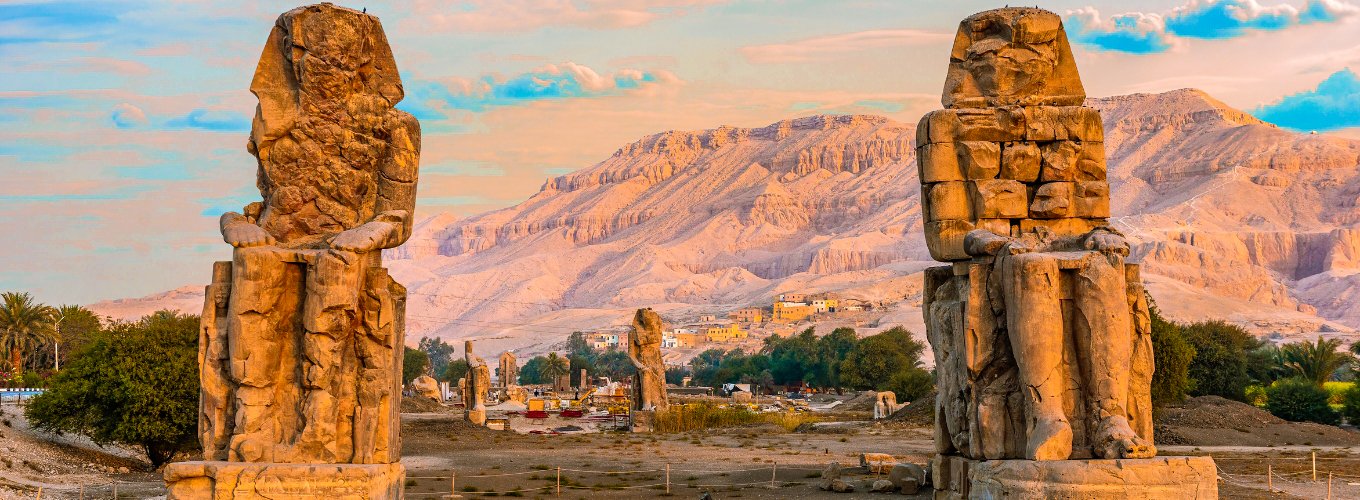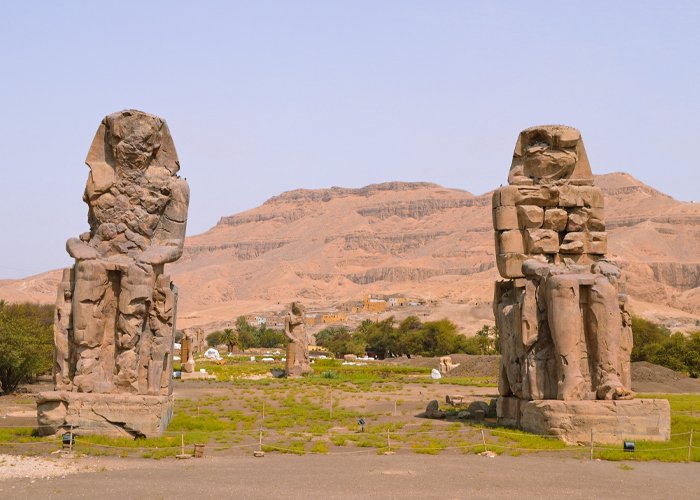Colossi of Memnon
The Colossi of Memnon welcome visitors to the west bank of Luxor with a presence that is as commanding today as it was over 3,400 years ago. These towering statues of Pharaoh Amenhotep III have withstood floods, earthquakes, and centuries of shifting sands, yet they continue to capture the imagination of travelers from around the world.
Rising nearly 18 meters high, the seated figures once guarded the entrance to a grand mortuary temple that has since vanished almost entirely. Despite the loss of the temple, the Colossi remain an iconic testament to the power, ambition, and artistry of ancient Egyptian civilization.
The Royal Symbolism Behind the Colossi
Constructed during the 14th century BCE in the 18th Dynasty, the statues represent Amenhotep III, one of ancient Egypt’s most powerful and successful rulers. Known for his prosperous reign and grand architectural projects, Amenhotep sought to immortalize his legacy through an enormous mortuary temple complex in Thebes, now modern-day Luxor.
The twin statues depict the pharaoh seated on a throne, hands resting on his knees, gazing east toward the rising sun and his capital city on the Nile’s opposite bank. Their alignment was not accidental—it symbolized the divine connection between the king and the sun god Ra, reinforcing the pharaoh’s role as both a ruler and a divine intermediary.

Each throne is richly decorated with scenes and hieroglyphs, showing Nile gods uniting Upper and Lower Egypt, along with carvings of Amenhotep’s mother and wife standing beside his legs. These elements emphasized the divine and familial legitimacy of his rule.
Though many of these details are weathered by time, their remnants still speak volumes to those who know where to look. Guides and Egyptologists help visitors uncover the hidden meanings that remain etched into the sandstone, connecting the statues not just to history, but to the legacy of divine kingship that was central to Egyptian ideology.
The Disappearance of the Mortuary Temple
While the Colossi have survived, the grand mortuary temple they once guarded has not. At the time of its construction, Amenhotep III’s temple was the largest and most opulent religious structure in all of Egypt—larger even than the Karnak Temple. It served as the center for rituals honoring the pharaoh after his death. Unfortunately, it was built too close to the Nile’s floodplain and was largely destroyed by repeated inundation and later by earthquakes.
Today, almost nothing of the original temple remains above ground. Ongoing excavations, however, continue to yield remarkable discoveries beneath the surface, from colossal statues and stelae to remnants of walls and sacred lakes.
Despite the temple’s disappearance, the Colossi stand as markers of its former glory. They provide scholars with crucial clues about Amenhotep III’s reign and the monumental scale of ancient Egyptian architecture.
For travelers, they serve as a gateway into one of Egypt’s most impressive and least understood sacred complexes, sparking curiosity and wonder as they imagine what once stood behind these towering sentinels.
The Singing Statue: Myth and Mystery in the Roman Era
In the centuries following their construction, the Colossi became famous across the Greco-Roman world for a strange and unexplained phenomenon. Beginning in 27 BCE, after a powerful earthquake cracked the northern statue, visitors reported hearing a musical or whistling sound emanating from it at dawn.
Ancient Greek and Roman travelers interpreted this as the voice of Memnon—a mythical Ethiopian hero from Homer’s Iliad who was believed to be the son of Eos, the goddess of dawn. According to legend, Memnon was killed in battle and his mother’s tears at sunrise were expressed through the statue’s “song.”
This fascinating occurrence transformed the site into a popular pilgrimage destination during the Roman Empire. Emperors, generals, poets, and aristocrats journeyed to Thebes to hear the statue “sing.”
Many left graffiti inscriptions on the statue’s legs recording their visit, some in praise of Memnon, others simply documenting their names and the date. These inscriptions are still visible today, offering a unique insight into the travelers of antiquity and their interaction with Egypt’s monumental landscape.
The sound ceased in the 3rd century AD after Roman Emperor Septimius Severus attempted to repair the statue. Although modern theories suggest the sound may have been caused by dew heating and evaporating through cracks in the stone, no one has successfully reproduced or verified the phenomenon, leaving an air of mystique around the “singing” Colossus.
Standing Witness to Millennia of Change
Over the centuries, the Colossi of Memnon have witnessed countless changes in Egypt’s landscape, culture, and politics. From the time of the pharaohs through Greek, Roman, Coptic, Islamic, and modern eras, these statues have endured as steadfast icons.
The very act of their survival, despite their exposure to the elements and shifting civilizations, makes them among the most resilient artifacts in the country.
For modern visitors, standing before the Colossi is not only about admiring their scale or artistry; it’s about connecting with an unbroken thread of human history.
Here, one can ponder how the same sky has arched above them for thousands of years, and how generations of travelers, just like today’s tourists, once stood in awe of their presence. The statues invite reflection on time, memory, and legacy—universal themes that resonate with anyone who has journeyed far to witness something eternal.
How to Visit the Colossi of Memnon
The Colossi are located on the west bank of Luxor, just a short drive from the Nile and easily accessible by taxi, tour bus, or guided excursion. Most organized tours to Luxor’s west bank include a stop at the Colossi along with visits to the Valley of the Kings, the Temple of Hatshepsut, and the Ramesseum.
Because the statues are in an open space and can be viewed without an entrance fee, some travelers choose to explore them independently.
Early morning is an ideal time to visit. The rising sun illuminates the statues beautifully, and the site is usually less crowded. This timing also allows for a cooler, more comfortable visit, especially during the warmer months. While there isn’t a formal visitor center at the Colossi, guides are often available on site or can be arranged in advance to provide historical context and explain the surrounding excavation efforts.
A Perfect Stop on a Larger Itinerary
As one of the key landmarks of the Theban Necropolis, the Colossi of Memnon are perfectly situated to fit into a broader Luxor itinerary. Travelers often combine their visit with a half-day or full-day tour that includes nearby tombs and temples. Just minutes away lies the Temple of Medinet Habu, one of the best-preserved temples on the west bank, built by Ramesses III.
Further along are the tombs of the Valley of the Kings, where Tutankhamun and other pharaohs were buried in elaborately decorated chambers deep within the limestone cliffs.
The west bank of Luxor offers not just historical depth, but a landscape of serene beauty—lush sugarcane fields, scattered palm groves, and the dramatic desert hills all combine to create a tranquil yet dramatic setting. For those interested in photography, the Colossi serve as a fantastic foreground with the Theban hills rising behind, especially during sunrise and sunset.
Recent Discoveries and Ongoing Excavations
In recent years, the area around the Colossi has been the focus of major archaeological projects. Excavations led by Egyptian and international teams have unearthed significant parts of Amenhotep III’s mortuary temple, including newly discovered statues, columns, and inscriptions.
These finds are gradually reshaping our understanding of one of Egypt’s most influential rulers and the scale of his ambitions.
The work is ongoing, and visitors can sometimes witness archaeologists in the field, a rare opportunity to see history literally being unearthed. Watching a team carefully brush sand away from a long-buried statue or recording details of a newly found relief can bring the ancient world to life in a way that static museum displays cannot. These discoveries not only enrich the story of the Colossi but also breathe new life into the legacy of the pharaoh who built them.
Cultural Significance and Enduring Legacy
Beyond their historical importance, the Colossi of Memnon hold a special place in Egypt’s cultural and national identity. They are among the most recognized monuments in the country, frequently featured in travel literature, documentaries, and tourism campaigns. Their image evokes a sense of timeless wonder and has become a symbol of Luxor’s rich archaeological heritage.
For Egyptians, the statues are more than tourist attractions—they are guardians of the past, embodying centuries of craftsmanship, devotion, and resilience. Their continued presence supports local tourism, provides jobs for guides and artisans, and inspires ongoing academic research. This layered importance ensures that the Colossi will remain relevant for generations to come.




Comments are closed